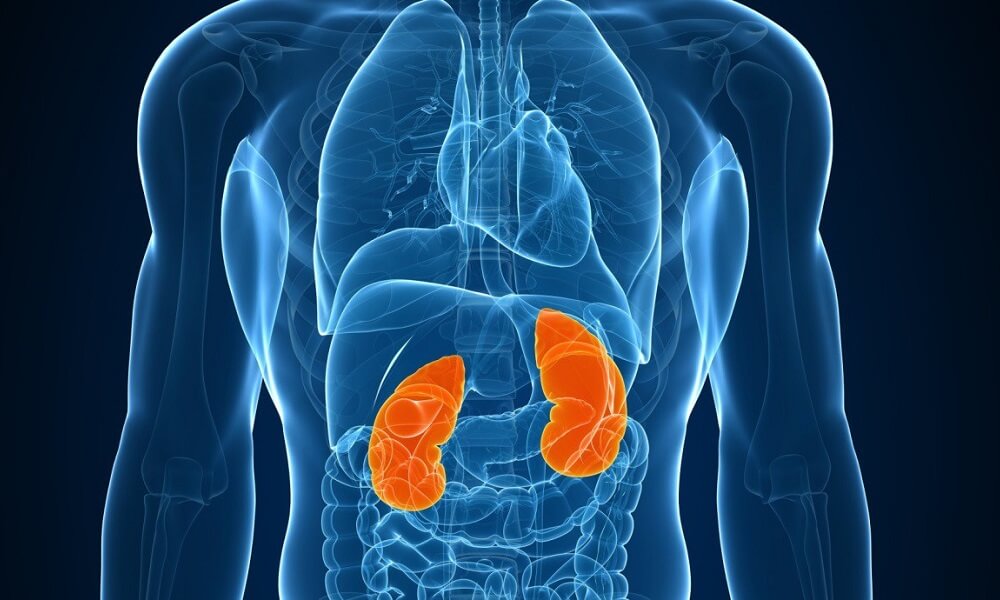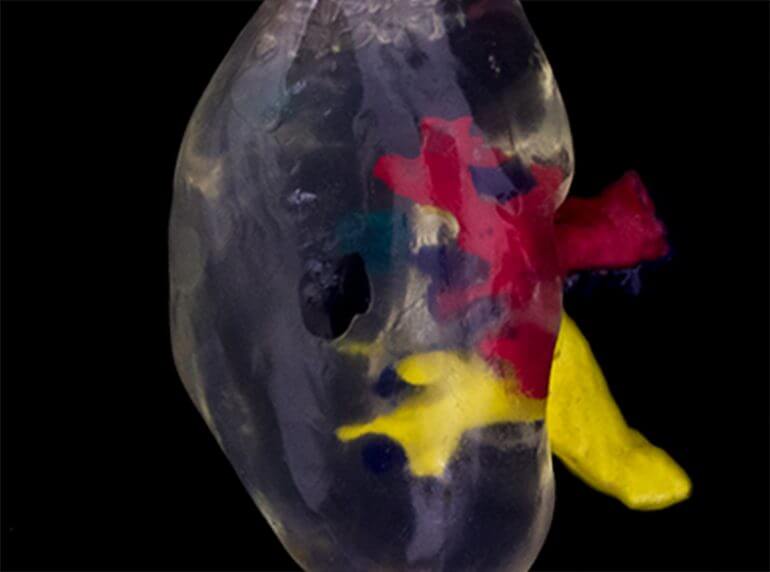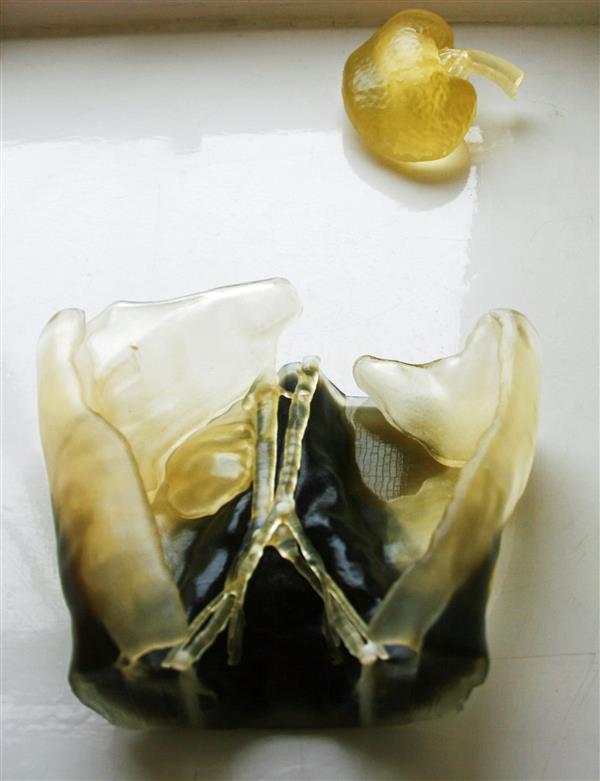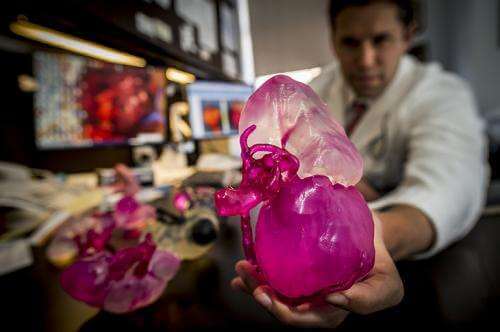3D printed kidney: What is actually possible?
Posted By Lucie Gaget on May 31, 2018 | 0 comments
The use of 3D printing in the medical sector keeps growing, and this technology is now offering new possibilities and new treatments. We recently talked about the use of 3D printing for jaw reconstruction and knee reconstruction. 3D printing is allowing personalized care and today, we are going to focus on kidney transplant using this cutting-edge technology. Is it possible to 3D print a human organ? How can 3D printing be used to cure kidney cancer? Some parts of the kidney are now 3D printable thanks to 3D bioprinting and it is also possible to get 3D printed kidney models to get a better visualization of a tumor.
10% of the world’s population suffer from kidney disease. But today, 3D printing can cure them and help them avoid dialysis. Let’s see how it is possible and what medical 3D printing has to offer us for the future.
3D printing for medical implants
Additive manufacturing applications are more and more widespread in the medical industry, as this technology is allowing to get custom-made parts adapted to the morphology and disease of the patient. We recently saw that 3D printing was a big asset for jaw and knee reconstruction, allowing to reconstruct exactly these specific parts, by reproducing the original shape of the bones. But what about organs? We are going to see that the medical 3D printing applications are numerous and that more and more medical interventions can be made using the 3D printing technology.
That is a fact, the evolution of 3D printing for healthcare is now helping to cure people suffering from kidney disease. Indeed, 16,000 people are receiving kidney transplants each year in the U.S, while 100,000 are still waiting for a donation. Is it possible to 3D print kidneys to help all of these patients with their kidney transplantation?
3D printed kidney parts
Thanks to the evolution of the bioprinting technology, some scientists of the Jennifer Lewis lab developed intricate tubes working on real kidneys. For the first time, scientists created artificial kidney tissue, working like real ones thanks to living cells. It is quite a revolution!
It is still complicated for the moment to 3D print a whole human kidney, as this organ has a complex structure and cellular architecture. But these tubes are a first step towards artificial kidneys.
https://www.technologyreview.com/s/602691/3-d-printed-kidney-parts-just-got-closer-to-reality/
Bioprinted mini kidneys have also been made, but these are dedicated to drug testing and won’t be transplanted. Tubules have been made using 3D printed tiny cells by Harvard researchers. This is the part of the kidney that reabsorbs nutrients and helps to get rid of waste.
3D printing a real kidney could be a true advantage and could help to fill the dramatic lack of donors. With this new progress made recently, we know that it will become possible in the upcoming years. The development of this impressive technique is on its way but it is taking quite some time to create real 3D printable organs using living cells! Soon, surgeons will be able to perform kidney transplants using 3D printing.
How does it work?
Using our capacity to develop bioprinting of tissues to create complex organs such as the kidney would definitely help to face organ shortages. But it is not that simple.
One of the many benefits is also that these 3D printed kidneys won’t be rejected by the patient’s body. Indeed, Biotech firms are currently working on using patients’ own stem cells to create custom-made organs. These stem cells would be the 3D printing material in this case. Using the patient’s stem cells would reduce the risk of organ rejection.
Researchers and surgeons have already been working on 3D printing stem cells, which is leading to new innovative applications! These have already been a success in 3D printing parts of complex organs such as liver and heart tissues. However, this is not enough to 3D print an entire functional organ.
3D printed human organs models: Why is it so helpful?
If it is not possible yet to get complete 3D printed organs, it is possible to get 3D printed models of the human organ that you want to heal. Let’s see how it is helpful for the healthcare community.
Saving lives thanks to 3D printing
3D modeling software are convenient tools to get a great visualization. For the medical industry, it is a way to get a good overview of the patient’s problems, to do simulation and find the best solution to heal the patient. These 3D images can also be 3D printed. It is allowing doctors to get a better understanding of the situation, and be totally prepared for the day of the surgery. Indeed, this way, they know exactly what they have to do and where is the eventual tumor that they have to remove, for example.
Axial3D
Belfast City Hospital in Northern Ireland planned a complex renal excision. Indeed, William Fenton, the father of the patient Pauline Fenton, was compatible to give his kidney, but as he didn’t have the same blood group, it was adding some complexity to the surgery.
They decided to 3D print a replica of the donor’s kidney in order to rehearse this complex complete excision. Indeed, the excision has to be precise and complete to be efficient and help the patient to be cured. This way, surgeons rehearsed the whole surgery to be ready, by taking into account all the possible complications.
This technique has also been used to save the life of a two years old baby at Guy’s and St Thomas’ NHS Foundation Trust in London. The abdomen of Dexter and the kidney of his father, the donor, have been 3D scanned and 3D printed to allow the surgeons to rehearse the operation and see all the possible complications. Indeed, it is not really common to transplant an adult kidney on a two years old baby. But this surgery is a real success!
http://www.3ders.org/articles/20180518-surgeons-use-3d-printing-for-two-year-olds-life-saving-complex-kidney-transplant.html
3D printing, allowing to save money and time
This 3D printed medical training is saving lives but is also a good solution to reduce the operation time and to reduce some costs. Regarding the kidney transplant made in Belfast City Hospital, the cost of this operation is estimated to be 83% cheaper than keeping the patient on permanent dialysis.
Moreover, by knowing exactly where is the tumor, surgeons are saving time during the operation. The Dr Yaser Al Saeedi working in Dubai Hospital is also using this technique to rehearse his kidney surgeries and get a perfect visualization of the problem. He affirms that 3D printing kidney models allow to save about 1 hour during the actual surgery!
Helping the patient to understand what is happening
Getting a representation of a human organ and of the tumor will help the patient to understand what is happening to them. This way, they can see clearly what is the problem. It is easier to understand the medical problem with a visual representation than with the traditional medical vocabulary! It is improving the patient’s comprehension and it can also be used for education, to get a concrete visualization of kidney cancer.
Dr. Jonathan Silberstein from the Tulane University Department of Urology is actually working with 3D printing and 3D prints kidneys before surgeries to show to the patients where their tumor is located.
Credit: Paula Burch-Celentano
He is using CT Scans to turn them into 3D models. Then, they use 3D printers to print them! As you can see on the picture, it is an accurate replica.
The future of 3D printing in the medical sector
The evolution of additive manufacturing for medical applications is amazing from 3D models for the surgeons to 3D printed prosthesis and soon 3D printed human organs. More and more impressive projects are becoming possible, thanks to this technology. 3D bioprinting will soon facilitate all of these medical projects, allowing to print human tissue and organs. Indeed, thanks to tissue engineering it will be possible to execute a complex organ transplant using fully 3D printed human organs.
The use of 3D printing for medical applications is really promising, the evolution of technologies and biocompatible 3D printing materials will help to produce real miracles. Kidney transplants using 3D printing will soon be a reality, saving millions of lives.
You want to create 3D printed organs replicas? Don’t hesitate and upload your 3D model right now on our online 3D printing service. We will take care of your 3D file. And if you have any question, ask our sales team!
If you want to read more blog posts about medical 3D printing, be sure to subscribe to our weekly newsletter.


 Connect with Google
Connect with Google Connect with Facebook
Connect with Facebook



